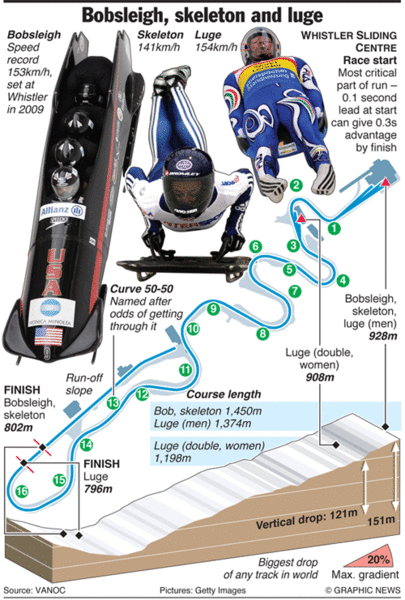Vancouver 2010 Olympic Games: Skeleton
Loading...
With the fastest track in the world, Whistler is sure to add even more adrenaline to the skeleton runs, on which speeds could exceed 90 m.p.h. Canada will be looking for Alberta standout Mellisa Hollingsworth to excel, while the US also has some strong contenders.
But perhaps more unexpected is the British team, whose two women are both ranked in the top five internationally. Shelley Rudman, the 2006 Olympic silver medalist, and Amy Williams were both introduced to the sport in Bath, England, where snow is rare but a push track enables athletes to train even in the above-freezing temperatures. Rudman’s boyfriend, Kristian Bromley, is ranked sixth for men.
Who to watch
Zach Lund, USA (see video)
A top medal contender in 2006, Lund was kicked out of the Olympic village days before his event for using a banned antibalding drug that can mask steroids. After his suspension, he rebounded to become No. 1 in the world. Though he's not as highly ranked this time around, Lund is worth watching because his experience highlights an often untold perspective on the doping issue: Given the monolith the antidoping movement has become, athletes can find it hard to navigate and may face inflexible penalties that critics say are disproportionate to their mistakes.
In Lund's case, he had declared the antibalding drug for years, but failed to realize it had been added to the list of banned substances going into the 2006 Olympic season – an oversight antidoping agencies are constantly warning athletes against, insisting it's their responsibility to check any drugs they're taking with the most current list. After Lund returned to competition, the drug was taken off the banned list – part vindication, part bitter reminder that he was denied a shot at gold for a drug that was no longer considered performance-enhancing.
In Whistler, he'll get another shot.
Mellisa Hollingsworth, CAN (see video)
A former cowgirl and rodeo participant, Hollingsworth is hoping to lasso gold for Canada this year to add to the historic bronze she won in 2006. It’s been a long road for the Alberta native, who nearly quit out of frustration in 2002 but kept with it and is now one of Canada’s most touted athletes at the Vancouver Games.
How does one decide to participate in a sport as crazy as skeleton? In Hollingsworth’s case, the idea came from her cousin, Ryan Davenport, a two-time World Champion in skeleton. Read more on her website.
Noelle Pikus-Pace, USA
Pikus-Pace’s dreams of ending her career with gold in 2006 were dashed when a rogue bobsledding team crashed into her, breaking her leg and her favorite sled. After time off to have a daughter, she’s rallied back – on a sled built by her husband, an engineer.
Other Americans to watch for: Katie Uhlaender, ranked seventh in the world. Uhlaender has two overall World Cup titles and one Olympics under her belt – not to mention two stints working for the TV show Survivor.
Event Details
Click here for schedule and results.
Men and women each take four runs down a track roughly a mile long. The athlete with the lowest combined time wins.
History
For the uninitiated, the sport of skeleton may sound like a bad dream: charging down an icy mountain track at speeds of up to 90 m.p.h. headfirst on a sled resembling a subway seat with runners. No seatbelts here.
But to enthusiasts, skeleton – named after the spare look of the sled – is the art of the controlled skid. Athletes adjust the bow of the runners, and the length of the spine – a narrower section of the runners that sticks out – depending on the demands of the track, including how hard the ice is.
A group of British tourists visiting St. Moritz in 1875 are credited with creating the skeleton. By inverting the position used in luge (feet-first, sliding on one’s back), riders were able to achieve new speeds and, undoubtedly, new adrenaline highs.
Skeleton has had a rather shaky presence at the Winter Olympic Games: it was included in the original 1928 Games, disappeared until the 1948 St. Moritz Games, and then was retired until it reemerged at the 2002 Salt Lake City Games.
Sources: vancouver2010.com, nbcolympics.com, Oxford Encyclopedia of World Sports






